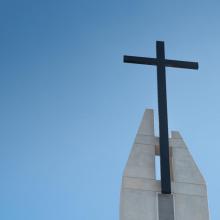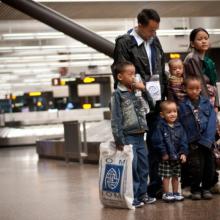Church World Service
IN 2016, PEOPLE of faith in the city of Billings, Mont., gathered to call for their community to get more involved in resettling refugees. With growing violence, persecution, and strife around the world and a record number of people forced to flee their homes, this community had the heart to help.
But the closest refugee resettlement office in the state was in Missoula, a 345-mile road trip west on I-90. The United States traditionally requires refugees to be resettled with families and relatives or close to these resettlement sites, which help new arrivals land on their feet and access needed services. For Billings — and for many other like-minded communities across the country — it was a logistical challenge to participate in the work of welcome.
Earlier this year, that changed. On Jan. 19, the Biden administration launched Welcome Corps, a new initiative giving everyday Americans the opportunity to sponsor refugees. Groups of at least five can now apply to form “private sponsorship groups,” which are responsible for welcoming refugee newcomers into their communities. These groups agree to assist in providing initial housing; as well as support access to health care, school enrollment, and employment opportunities; and otherwise engage directly in the life-changing work of refugee resettlement.
Three faith-based resettlement agencies say it will be easier to welcome refugees after a federal appeals judge ruled in their favor to block President Donald Trump’s executive order allowing local and state officials to refuse refugees.
On Nov. 12, at a virtual event celebrating the 40th anniversary of Jesuit Refugee Service, President-elect Joe Biden doubled down on his promise to increase presidential determination for annual refugee admissions to 125,000. That pledge marks a big increase from the record low of 15,000 refugee admissions President Donald Trump had set for the 2021 fiscal year.

'Refugees Welcome' sign at a Protest Rally at the U.S. Supreme Court. June 26, 2018 in Washington, D.C. Photo by Jerome460 / Shutterstock.com
A federal judge on Wednesday blocked the Trump administration from enforcing an executive order that would allow state and local governments to opt out of the refugee resettlement program.
“WE'D NEVER ORGANIZED civil disobedience around refugee resettlement before—we’ve never really had to. Refugee resettlement has always had bipartisan support.
But when there was news the administration would again be cutting the refugee resettlement number, a lot of folks—especially from religious communities—felt we had to respond in a way that was different from what we had done before. I mean, how many times can you write a scathing statement expressing outrage, right?

Image via REUTERS/Chris Helgren.
Even more difficult than the question of whether or not we are collectively willing to break the law is the question of whether we are ready to embody what a “culture of sanctuary” holistically invites us to be.
The Trump administration’s hard-line stance on undocumented immigrants is polarizing: People have responded with either “throw the bums out” or “have a heart.” But the question of whether faith communities can legally offer the undocumented physical sanctuary — sheltering them in churches, synagogues, and mosques to keep them from immigration authorities — is not so cut and dry.

Image via Ken Rowland/flickr.com
More than 800 congregations have declared themselves sanctuaries for undocumented immigrants, about double the number since Election Day.
Leaders of the sanctuary movement say the pace of churches, and other houses of worship, declaring themselves sanctuaries has quickened, in the days leading up to the inauguration of President-elect Donald Trump on Jan. 20.
Nearly 200 religious and civil rights groups are petitioning President Obama to dismantle the regulatory framework behind a Homeland Security program critics say discriminates against Muslims and Arabs.
President-elect Donald Trump has appointed one of the architects of the program, Kris Kobach, to his transition team. That, and Trump’s own calls on the campaign trail for “extreme vetting” of immigrants, have led some to believe that he will revive the National Security Exit-Entry Registration System.

Image via Thanate Rooprasert/Shutterstock.com
First came the mayors of New York, Chicago, and Seattle declaring their cities “sanctuaries”, and saying they will protect undocumented immigrants from President-elect Donald Trump’s plan to deport them.
Then thousands of students, professors, alumni, and others at elite universities, including Harvard, Yale, and Brown, signed petitions, asking their schools to protect undocumented students from any executive order.
Now, religious congregations, including churches and synagogues, are declaring themselves “sanctuaries” for immigrants fleeing deportation.
World Relief, a Christian humanitarian group, resettled twice as many refugees to the U.S. in September as it had in August, an increase that foretells a more robust resettlement pace for the nation in general.
The evangelical nonprofit — one of the nine groups entrusted by the federal government to resettle refugees — found homes for approximately 1,400 people in September. That’s about 14 percent of the total refugees it resettled in the past year.
My child ate today. Breakfast was pancakes and sausage.
Walking to school I said, “If you don’t like the leftover hamburger that I put in your lunchbox, just buy something from the cafeteria. You have plenty of money in your account.”
Tonight we will have tacos, but if I am too tired to cook, we will order pizza.
I am grateful that I can feed my child every day.







